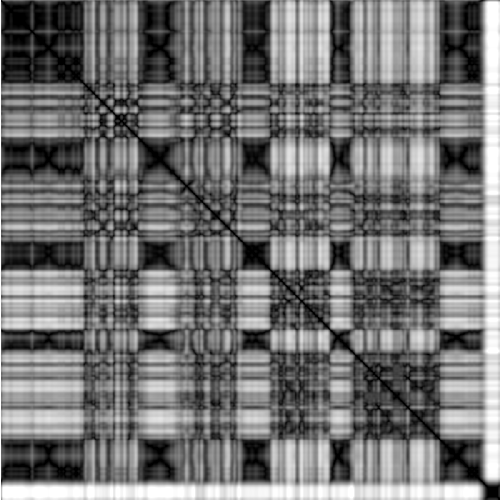21. Das Wirtshaus. (The Inn)

Variiertes Strophenlied in F-Dur mit vier Strophen. [more]
Normalized variant of the well-known MFCC features (3 sec), the low bands are loosely correlated to timbre. [more]
Singer: Gerhard Hüsch (Baritone), Piano: Hanns-Udo Müller. Recorded on vinyl, April-September 1933.
Source, License: EA Terms of Use
Information about our segmentation of »21. Das Wirtshaus«
Variiertes Strophenlied in F-Dur mit vier Strophen.
Das instrumentale Vorspiel bildet im Wesentlichen die Begleitstimme des gesamten Liedes.
Die Zwischenspiele I2 stellen die zweite Hälfte des Vorspiels I1 dar.
B und C können als starke Variationen von A angesehen werden, wobei die Rhythmik immer gleich bleibt. Die Harmonik und die Melodik weichen zuweilen stark von dem Original (A) ab.
Mögliche Segmentierungen:
I1 A I2 A I2 B C I2
I1 A1 I2 A1 I2 A2 A3 I2
Lyrics: Project Gutenberg
MFCC (Mel Frequency Cepstral Coefficients)
This feature was originally developed for speech analysis and speaker recognition. After transforming a musical signal in a spectrogram representation, MFCC-based features are computed by combining suitable frequency bands into percepually inspired Mel bands and applying a decorrelating discrete cosine transformation. Especially, the lower MFCC bands describe the coarse form of the spectral envelope which correlates to timbre. For deriving MFCC-ENS features (MFCC Energy Normalized Statistics), these MFCC features are quantized, smoothed (in temporal direction), and normalized with respect to the ℓ2-norm.
Furthermore, we present a novel variant of MFCC-ENS features by prior weighting the spectrogram by the second derivative of the spectral phase information in the time domain. This indicates slight changes in pitch which typically occur in vocals and which are not present in piano music. Especially the harmonics of piano-played notes are attenuated by this method which leads to smaller spectral envelopes in the piano sections and hence to more discriminative timbre-related MFCC features.
Literature
- Steven Davis, Paul Mermelstein: Comparison of parametric representations for monosyllabic word recognition in continuously spoken sentences, Readings in Speech Recognition 1990, pp. 65–74.
- Hiroko Terasawa, Malcolm Slaney, Jonathan Berger: The thirteen colors of timbre, WASPAA 2005, pp. 323–326.
- Dirk v. Zeddelmann, Frank Kurth: A construction of compact MFCC-type features using short-time statistics for applications in audio segmentation, EUSIPCO 2009, pp. 1504–1508.
